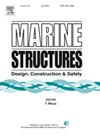船用涂砂复合玻璃钢管:海水下与海水-海砂混凝土的粘结性能
IF 5.1
2区 工程技术
Q1 ENGINEERING, CIVIL
引用次数: 0
摘要
在模拟海洋环境下,研究了涂砂复合碳-玻璃纤维增强聚合物(HFRP)管与海水-海砂混凝土(SWSSC)之间的粘结耐久性。将混凝土填充长丝缠绕的HFRP管浸入温度分别为25°C、40°C和60°C的海水中,时间分别为30、90和120天。通过推出试验来评估FRP混凝土筒(CFFTs)的粘结性能,重点关注破坏模式、粘结强度和粘结滑移特性。结果显示,与非条件对照相比,30天后所有条件样品的粘结强度都有初步增强,随后逐渐下降,120天后粘结强度最大下降9%。有条件试件的主要破坏模式发生在HFRP管与涂砂层的界面处,无条件试件的主要破坏模式发生在钢管与混凝土的界面处。研究发现,峰值后的键合行为各不相同,键合强度要么保持不变,要么逐渐降低,这主要是由于化学附着力和摩擦的丧失。使用fib Bulletin 40方法,对于在海水环境中使用寿命超过50年的粘结强度耐久性,推荐的击倒因子为0.5。这项研究强调了砂包覆HFRP管和SWSSC作为可持续的、海洋兼容的建筑材料的潜力,满足结构耐久性要求。本文章由计算机程序翻译,如有差异,请以英文原文为准。
Sand-coated hybrid FRP tubes for marine applications: Bond performance with seawater-sea sand concrete under seawater
This study investigates the durability of the bond between sand-coated hybrid carbon-glass fibre-reinforced polymer (HFRP) tubes and seawater-sea sand concrete (SWSSC) under simulated marine conditions. Concrete-filled filament-wound HFRP tubes were immersed in seawater at temperatures of 25 °C, 40 °C, and 60 °C for durations of 30, 90, and 120 days. Push-out tests were conducted to evaluate the bond performance of the concrete-filled FRP tubes (CFFTs), focusing on failure modes, bond strength, and bond-slip characteristics. Results revealed an initial enhancement in bond strength for all conditioned samples after 30 days compared to unconditioned references, followed by a gradual decline, culminating in a maximum bond strength reduction of 9 % after 120 days. The primary failure mode for conditioned specimens occurred at the interface between the HFRP tube and the sand-coated layer, while unconditioned specimens failed at the interface of the tube and the concrete. The study found that post-peak bond behaviour varied, with bond strength either maintained or gradually reduced, mainly due to the loss of chemical adhesion and friction. Using the fib Bulletin 40 approach, a knock-down factor of 0.5 is recommended for bond strength durability over a 50-year service life in seawater environments. This research stresses the potential of sand-coated HFRP tubes and SWSSC as sustainable, marine-compatible construction materials that meet structural durability requirements.
求助全文
通过发布文献求助,成功后即可免费获取论文全文。
去求助
来源期刊

Marine Structures
工程技术-工程:海洋
CiteScore
8.70
自引率
7.70%
发文量
157
审稿时长
6.4 months
期刊介绍:
This journal aims to provide a medium for presentation and discussion of the latest developments in research, design, fabrication and in-service experience relating to marine structures, i.e., all structures of steel, concrete, light alloy or composite construction having an interface with the sea, including ships, fixed and mobile offshore platforms, submarine and submersibles, pipelines, subsea systems for shallow and deep ocean operations and coastal structures such as piers.
 求助内容:
求助内容: 应助结果提醒方式:
应助结果提醒方式:


